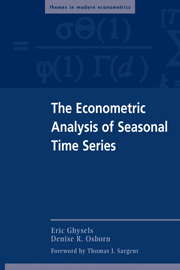Book contents
- Frontmatter
- Contents
- Foreword by Thomas J. Sargent
- Preface
- List of Symbols and Notations
- 1 Introduction to Seasonal Processes
- 2 Deterministic Seasonality
- 3 Seasonal Unit Root Processes
- 4 Seasonal Adjustment Programs
- 5 Estimation and Hypothesis Testing with Unfiltered and Filtered Data
- 6 Periodic Processes
- 7 Some Nonlinear Seasonal Models
- Epilogue
- Bibliography
- Subject Index
- Author Index
7 - Some Nonlinear Seasonal Models
Published online by Cambridge University Press: 05 June 2012
- Frontmatter
- Contents
- Foreword by Thomas J. Sargent
- Preface
- List of Symbols and Notations
- 1 Introduction to Seasonal Processes
- 2 Deterministic Seasonality
- 3 Seasonal Unit Root Processes
- 4 Seasonal Adjustment Programs
- 5 Estimation and Hypothesis Testing with Unfiltered and Filtered Data
- 6 Periodic Processes
- 7 Some Nonlinear Seasonal Models
- Epilogue
- Bibliography
- Subject Index
- Author Index
Summary
Introduction
This chapter is the least comprehensive of all chapters in this book. It has no pretention to represent the current state of the literature. Instead, it is highly selective in its coverage of topics. There are several reasons for the approach taken in this chapter. First, while there have been many developments on the frontier of linear time series analysis of seasonal processes, it is clear that the topic of nonlinear models is very much unsettled at this point. Second, the subject of nonlinear time series models in general does not enjoy the same level of acceptance and agreement as the topic of linear time series models does. Seasonal models are no exception. Moreover, as this book is being written, there is an emerging field of high-frequency financial data that is very much in its early stages of development.
High-frequency data are most commonly, though not exclusively, encountered in finance. These are transaction based, irregularly spaced, and frequently observed time series. They reach the ultimate level of disaggregation, and therefore are sometimes called ultra-high-frequency data [see Engle (2000)]. Seasonality of a different type is a major source of time series fluctuations in high-frequency data. These are not quarterly or monthly seasonals; they are so called intradaily seasonal patterns. The sheer number of data points and the complexity of the seasonal patterns pose still many challenges to time series econometricians.
- Type
- Chapter
- Information
- The Econometric Analysis of Seasonal Time Series , pp. 182 - 202Publisher: Cambridge University PressPrint publication year: 2001



